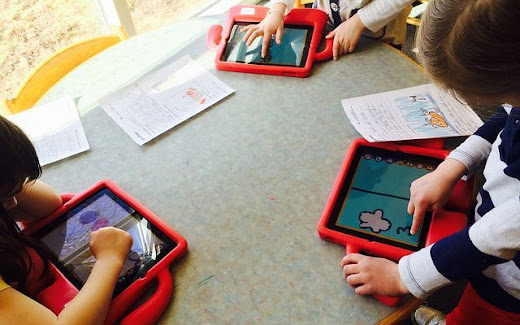4 Everything You Wanted to Know About ED TECH COMPANY and Were Afraid To Ask
What Is EdTech? What Is EdTech? Its Definition, Explanation, and Advantages
Hardware and software designed to enhance teacher-led classroom learning and enhance students' educational outcomes are referred to as "EdTech," which is a combination of the terms "education" and "technology."
Although EdTech is still in its infancy, it shows promise as a method for adapting a curriculum to a student's ability level by introducing and consolidating ed tech company new material at a pace the student can handle.
"education technology," abbreviated as "ed-tech," refers to innovative technological applications in the classroom.
Examples of EdTech include interactive whiteboards and projection screens in the classroom, online content delivery, and massive open online courses (MOOCs).
The objective of EdTech is to develop understudy results further, upgrade individualized training, and lessen the showing trouble for teachers.
While many applaud the use of technology in the classroom, others worry that it will lead to data collection and tracking of both students and teachers and will be impersonal.
Understanding EdTech Education technology can be contentious. There are concerns that EdTech is an attempt to phase out specific in-class duties to cut costs, given that a significant portion of the educational system is unionized. However, the creators of EdTech emphasize the software and technology's enhancement potential, allowing teachers to become more facilitators. It is difficult for a teacher to teach according to the curriculum, catch up with lower-level students, and keep the top students engaged when time is limited. In addition, EdTech can improve outcomes for individual students and the class by automating ability assessments and difficulty adjustments.
There were two implementation waves of classroom technology.
The introduction of hardware into the classroom was the first. As a result, improving the software to coordinate and utilize all the hardware has unavoidably come up. EdTech refers to these software solutions. Many are cloud-based and use educational research to create algorithms that determine how quickly or slowly a student should advance toward various learning objectives.
Utilizing technology, Massive Open Online Courses (MOOCs) reach many online students worldwide. Even though these courses also have problems, like low completion rates, they try to educate users in a way that works for them.
Concerns About EdTech Many people are worried about EdTech because it looks further into the future, where software can manage entire courses. Analytics assess a student's competence in various curriculum areas, allowing the student to advance more quickly in some areas while taking more time to strengthen weaker ones. As every understudy technology for teaching and learning manages a tweaked educational program, the educator goes about as a facilitator and inconvenience shooter with experiences from the EdTech programming on an understudy's assets and shortcomings.
In practice, even for fundamental subjects like math, reading, and writing, EdTech is still in its infancy. As a result, EdTech faces numerous design difficulties. Adapting to different learning styles in the classroom presents the most significant challenge. EdTech is typically presented via laptop or tablet, resulting in a read-and-reply learning environment. Critics have noted that this teaching method may disadvantage other learning styles, such as auditory and kinesthetic learners. EdTech, like any new technological field, will improve the more it is used and the more feedback it gets.
However, EdTech also faces social challenges. Parents and students alike look to teachers to create a social setting that encourages group learning and other dynamics not currently covered by EdTech. Even though the future classroom will heavily rely on EdTech to design courses, many parents and educators still see value in the group set apart from the academic objectives. EdTech, according to its proponents, seeks to enhance rather than completely replace the existing model, as many innovations in education do.
Example of a Publicly Traded EdTech Company As of March 2020, K12 Inc. (LRN) is a major player in the education technology industry. It primarily focuses on providing kindergarten through 12th-grade students with individualized learning through software, services, and curriculum.
The company provides additional learning tools and courses, full-time virtual classrooms, and individual courses.
What is the point of interfaces?
No matter what level of your system of interest (SOI), systems are made up of subsystems, are a part of other systems and interact with other systems at the same architecture level. This is true for hybrid hardware/software systems, simple hardware systems, and complex software systems alike. Interfaces are the interactions between your system and other systems.
You can better define the boundaries of your system by recognizing interfaces. Understanding interfaces also help you comprehend the relationships between your system and other systems and between your system and others. Failure to identify an interface is a common cause of products that do not meet stakeholder expectations and can adversely affect your project. Missing or erroneously characterized connection points are many times a significant reason for cost overwhelms
furthermore, item disappointments.
By delineating interfaces, you can ensure that your system and any other systems you need to interact with are compatible. Before testing, many projects need to identify and control their interfaces.
People frequently encounter the consequences of this oversight for the first time when they discover that they cannot connect test equipment to their system to carry out the tests. Worse still, consider the issues that arise when you hand over control of your educational media system to operations and discover a missing interface that prevents your system or another system that is dependent on it from functioning. If you identify and manage your external interfaces early, you can identify critical drivers for your product that must be addressed in your system requirements.
Additionally, identifying interfaces aids in identifying project risks and potential issue areas. You will frequently be required to interface with established systems that cannot be altered; this may or may not pose a problem, but you should be aware of it.
If you need to know what your interfaces are or the characteristics of those interfaces, how can you create system requirements? To ensure compatibility with existing systems or collaborate with the other developing system to jointly define the interfaces, so you are compatible, you need to be aware of any issues with your interfaces early.
Due to the inherent risks associated with a system's interfaces, serious issues can arise at interfaces. Your system is vulnerable at its interfaces because they represent systems you do not control. Your system will be affected if an interface needs to be clarified or is subject to change. There is also the possibility that someone outside of your system willfully or unintentionally alters the performance of your system. "If you want to sabotage someone's system, do it at an interface" is an old proverb.
The project's System Engineer, lead Software Engineer, Business Analyst, or anyone else involved in developing requirements should prioritize interfaces because of the importance of identifying, defining, developing, and managing interface requirements.
Given their significance, there would be a standard procedure for identifying and defining interfaces, creating interface requirements, and managing these activities.
Sadly, there is not one. Each industry and organization manage these activities differently because of their distinct cultures. As a result, it is hard to tell where to record this information or even what to call it.
There are some guiding principles and best practices that you can follow, regardless of the names we give to the various documents that contain information about interfaces. These best practices are based on what we have learned from trying various approaches to managing interface requirements and seeing which ones work best and which usually cause problems.
What exactly is an interface?
An interface is a boundary between two or more parts allowing interaction. A different definition is: An interface is a device's design feature that affects or is affected by another system's design feature. Figure 1 shows this interaction.
Image 1: 9 What is an interface and how does it work?
A shared physical or functional boundary between two systems where they interact.
Mechanical attach point voltage Data Command Media 3 of 14 www.reqexperts.com The critical words in this sentence are "interact" and "affects or is affected by another system." Sys 1 Sys 2 Interface Boundary From a requirements perspective, an interface is involved whenever a requirement's wording suggests or implies one of these conditions. A requirement that deals with an interface is referred to as an interface requirement if it involves one.
Understanding what an interface is not is also crucial. Examples of what an interface needs to be shown in Figure 2.
Image 2: Examples of what does not constitute an interface
Sadly, we hear statements like these all the time. The first requirement is based on the false assumption that the interface is a system with functionality. The second assumes that interfaces are things and are a requirement for designers. Connectors, bolts, and university of management and technology other items should be made accessible as a prerequisite. The third and fourth again make the assumption that the interface exists. Any system's hardware or software interfacing with another system must meet these requirements. The conclusion: There should be no "The interface shall" requirements.



.png)
Comments
Post a Comment